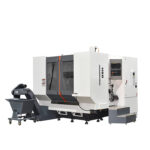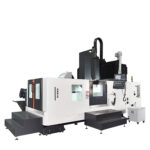In the ever – evolving world of manufacturing, machining centers are on the cusp of a revolutionary transformation, driven by the power of Artificial Intelligence (AI) and the Internet of Things (IoT).
I. The Current State of Machining Centers
Machining centers have long been the workhorses of the manufacturing industry. They are used to shape, cut, and form various materials with high precision. However, traditional machining centers often face challenges such as inefficiencies in production scheduling, difficulty in predicting tool wear, and limitations in adapting to rapid changes in product designs.
II. AI in Machining Centers
Predictive Maintenance
AI algorithms can analyze data from sensors placed on machining components. These sensors can monitor factors like vibration, temperature, and power consumption. By continuously analyzing this data, AI can predict when a machine part is likely to fail. For example, if a spindle’s vibration pattern starts to deviate from the normal range, the AI system can alert the operators in advance, allowing for preventive maintenance. This not only reduces downtime but also extends the lifespan of the machining center.
Optimized Production Scheduling
AI – powered software can take into account multiple variables such as order priorities, available raw materials, and machine capabilities to create the most efficient production schedules. It can dynamically adjust the schedules in real – time based on unforeseen events like rush orders or machine breakdowns. For instance, if a high – priority order comes in, the AI system can quickly re – arrange the production sequence to ensure its timely completion without disrupting the overall production flow.
Quality Control
Machine vision systems integrated with AI can inspect parts during and after machining with a high level of accuracy. AI can learn to recognize even the slightest defects in the parts based on a large number of training samples. This enables the machining center to produce parts with consistent high quality, reducing the need for manual inspection and minimizing the risk of defective products reaching the market.
III. IoT in Machining Centers
Inter – Machine Communication
IoT allows machining centers to communicate with each other within a manufacturing facility. For example, a milling machine can send data about its current workload and available resources to a lathe. This enables better coordination between different machines, so that they can share tasks and optimize the overall production process. If one machine is overloaded, it can offload some of its tasks to another machine that has spare capacity.
Supply Chain Integration
Machining centers can be connected to the broader supply chain through IoT. They can receive real – time information about the availability of raw materials from suppliers. This helps in better inventory management as the machining center can adjust its production based on the actual arrival time of raw materials. At the same time, it can also send information about the status of finished products to distributors, enabling a more seamless flow of goods from the factory to the market.
Remote Monitoring and Control
With IoT, operators can remotely monitor the status of machining centers. They can access data such as machine operation parameters, production progress, and error messages from anywhere in the world. In some cases, they can even remotely control the machines to make adjustments or start/stop operations. This is especially useful for multi – site manufacturing companies, where experts can oversee and manage machining centers in different locations without having to be physically present at each site.
IV. The Future Outlook
Autonomous Machining Centers
In the future, we can expect to see machining centers that are fully autonomous. These centers will be able to operate without continuous human intervention. AI and IoT will work in tandem to enable the machines to receive orders, plan their own production processes, source raw materials, and deliver finished products. For example, an autonomous machining center in a smart factory could receive a digital design of a part from a customer, analyze the requirements, and then produce the part without any human input other than the initial order placement.
Sustainable Machining
As environmental concerns grow, AI and IoT will play a crucial role in making machining centers more sustainable. AI can optimize the use of energy and resources by precisely controlling the machining processes. IoT can enable better recycling of materials by tracking the flow of waste and by – products within the manufacturing facility. For instance, sensors can detect when a certain amount of metal scrap is generated and trigger a system to recycle it immediately.
Personalized Manufacturing
The combination of AI and IoT will also drive the trend towards personalized manufacturing. Machining centers will be able to quickly adapt to produce customized products in small batches. AI can analyze customer – specific requirements and adjust the machining parameters accordingly. IoT can ensure that the necessary raw materials and components are available for personalized production. This will open up new markets for manufacturers, as consumers increasingly demand unique and personalized products.
In conclusion, the integration of AI and IoT in machining centers is set to redefine the future of manufacturing. It will bring increased efficiency, improved quality, and greater sustainability to the machining industry. Manufacturers who embrace these technologies early will gain a competitive edge in the global marketplace.





